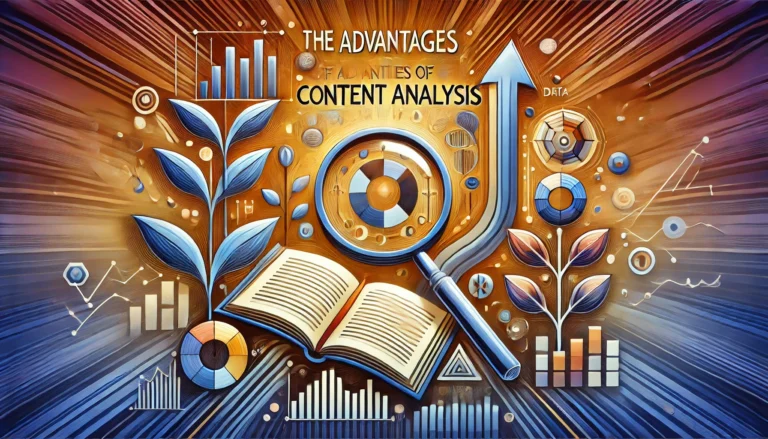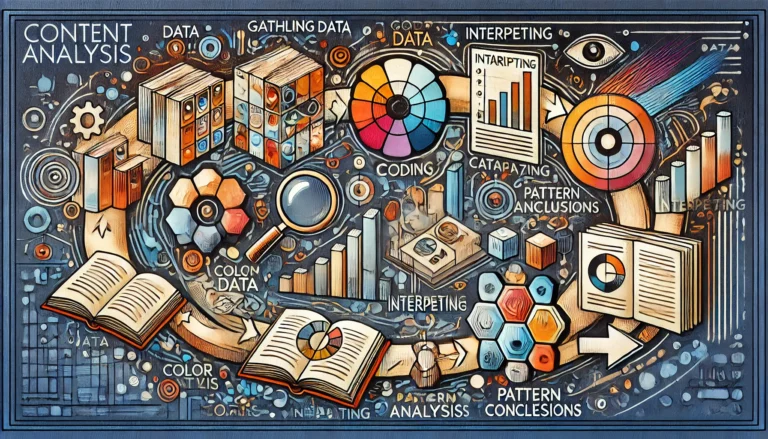Content Analysis
Content analysis is a research methodology employed to identify patterns in reported communication. Content analysis is the systematic collection of data from a specific set of texts, which can be in written, oral, or visual form.
- Books, newspapers, and magazines
- Speeches and interviews
- Web content and social media posts
- Photographs and films
Content analysis can encompass both quantitative, which involves the process of counting and measuring, and qualitative, which involves the process of interpreting and understanding. In both forms, you classify or “encode” words, themes, and concepts inside the texts and subsequently examine the findings.
The technique is regarded as unobtrusive since researchers analyze pre-existing messages instead of obtaining new texts from individuals. The vast majority of content analyses employ quantitative procedures, which involve selecting texts, determining the units to be coded, developing content categories, training observers to code units, and analyzing the data.
Comparison as Quantitative and Qualitative Method
Quantitative Content Analysis
A systematic and periodic methodology is employed to address study questions and verify hypotheses. It involves the process of quantifying and classifying basic components of content in order to provide numerical information. Subsequently, this data conducts statistical analysis. Analyzing the occurrence rate of particular words, phrases, or groups to provide evidence for qualitative findings.
- Objective Analysis: Utilizes statistical techniques to examine numerical data.
- Deductive Approach: Before data analysis, researchers establish coding categories.
For example, to investigate the significance of employment concerns in political campaigns, one could examine campaign speeches to determine the frequency of terms like unemployment, jobs, and work. Statistical analysis can then be employed to identify variations over time or across different candidates.

Qualitative Content Analysis
Researchers are more concerned with the meanings attached to messages than with the frequency of message variables. This approach emphasizes the understanding of the fundamental themes, meanings, and patterns that underlie textual data. It entails subjective analysis and interpretation.
- Subjective Analysis: Researchers exercise their judgment in order to find and investigate pivotal components.
- Inductive Approach: Themes and classifications frequently arise organically from the data itself.
For example, to gain a deeper understanding of job problems in political campaigns, one could analyze the usage of the word “unemployment” in speeches. By identifying the associated words or phrases, such as “economy,” “inequality,” or “laziness,” one can better comprehend the underlying meanings and intentions of different campaigns.
Mixed-Method Content Analysis
Frequently, the most influential content analysis research blends both qualitative and quantitative methodologies. This mixed methodology offers a thorough comprehension of the text by combining both qualitative and quantitative methodologies. Qualitative analysis involves the identification of fundamental themes and concepts, while quantitative analysis focuses on measuring the frequency and distribution of these themes.
For instance, a researcher investigating the media portrayal of climate change might conduct a qualitative analysis of news stories to discover the prevailing patterns and discussions surrounding climate change. The researcher might also quantitatively analyze the frequency of certain terms connected to climate change to evaluate the overall extent of coverage.
Purpose of Content Analysis
It has mainly the following purposes:
- Finding correlations and patterns in how concepts are communicated
- Understanding the intentions of an individual, group, or institution
- Identifying propaganda and bias in communication
- Revealing differences in communication in different contexts
- Examining the effects of communication content, such as the delivery of information or the reactions of the audience.
Advantages of Content Analysis

Unobtrusive Data Collection
Communication and social interaction can be analyzed by non-participant observation, ensuring that the presence of the researcher does not exert any influence on the results.
Transparent and Replicable
When conducted well, content analysis adheres to a systematic process that other researchers can easily duplicate, resulting in highly reliable findings.
Highly Flexible
Content analysis can be conducted at any time and in any location, requiring just access to the relevant sources and requiring minimal costs.
Disadvantages of Content Analysis
Reductive
Concentrating just on particular words or phrases can often be excessively simplistic, ignoring the surrounding context, differences, and other interpretations.
Subjective
Content analysis typically entails a degree of subjective interpretation, which can impact the validity and reliability of the findings and conclusions, resulting in different forms of research bias and cognitive bias.
Time Intensive
Engaging in manual coding of vast amounts of text is very time-consuming, and achieving effective automation might pose challenges.
Steps in Content Analysis
In order to employ content analysis in your research, it is essential to begin with a well-defined and unambiguous research question. For example, is there a difference in religious intolerance among different schools of thought? You need to follow these five steps.

Select the Content
Select the texts that you will study based on your research topic. You have to make a decision:
- The medium refers to a specific form of communication, such as newspapers, speeches, or websites. The genre, on the other hand, pertains to the particular style or category of the content, such as opinion articles, political campaign speeches, or marketing copy.
- The criteria for inclusion and exclusion encompass several sources, such as newspaper stories referencing a specific event, speeches delivered by a particular politician, or websites offering a particular type of goods.
- The parameters refer to specific criteria such as date range and location.
If there is a limited number of texts that satisfy your criteria, it may be feasible to study each of them. If there is a substantial amount of text, you have the option to choose a representative sample.
In order to address this research inquiry, you decide to examine news stories and speeches during the period spanning 2017 to 2019. Due to the extensive amount of content, you might select three prominent national newspapers and analyze only the editions published on Mondays and Fridays.
Define Units and Categories
Subsequently, it is vital to ascertain the specific level at which you will conduct the analysis of your selected texts. This entails establishing clear and precise definitions for:
- The unit(s) that will be encoded with a specific meaning. Will you be documenting the frequency of specific words and phrases, the attributes of individuals who created or are featured in the texts, the inclusion and arrangement of images, or the handling of themes and concepts?
- The coding framework comprises the set of categories that you will utilize for classification purposes. Categories can encompass either concrete attributes (such as sect or religious scholar) or more abstract concepts (such as modern or conservative).
The units of analysis in this study are the religious experts featured in each article, as well as the specific words and phrases used to describe them. In accordance with your research topic, you must classify individuals according to their religious group and their adherence to conservative principles.
Develop Set of Rules
Coding entails the systematic arrangement of meanings into pre-established categories. When dealing with conceptual categories, it is crucial to establish clear guidelines for what will and will not be included in order to ensure consistent coding of all texts.
Establishing coding protocols is crucial, particularly when numerous researchers are collaborating. However, even when coding alone, establishing the principles enhances the transparency and reliability of your methodology.
When determining the classification of “religious scholar,” you must select which titles will be assigned to this category, such as mosque caregiver, religious student, and renowned scholar. With “Conservative”, you decide which specific words or phrases related to conservative (e.g., primitive and stubborn) will be coded in this category.
Code the Text
You carefully examine each text and document all pertinent information in the relevant categories. The task can be accomplished either manually or with the use of computer programs, such as QSR-NVivo [1], and ATLAS.ti [2] and Diction [3], These programs can facilitate the process of quantifying and classifying words and phrases, hence increasing efficiency.
Following to your coding guidelines, you analyze every newspaper story and speech inside your sample. You record the characteristics of each scholar mentioned, along with all words and phrases related to conservativeness that are used to describe them.
Analyzing Results
After the coding process is over, the gathered data is analyzed to identify patterns and make conclusions in relation to your research questions. Statistical analysis can be employed to identify correlations or trends, analyze and evaluate the implications of the findings, and draw judgments about the producers, context, and audience of the texts.
1 QSR NVivo is a software application specifically designed for qualitative data analysis. It’s used by researchers across various fields, including social sciences, humanities, and market research. It helps you manage and organize large volumes of qualitative data, such as interview transcripts, focus group recordings, and documents.
2 ATLAS.ti is another popular software application specifically designed for qualitative data analysis. Like NVivo, it’s widely used across various academic and research fields. It helps to organize and manage qualitative data, code and categorize data segments, analyze and identify patterns within data, visualize data for better understanding and communication.
3 Diction refers to the choice of words used by a writer or speaker. It’s about selecting the right words to effectively convey a message, create a specific tone, or evoke certain emotions.






